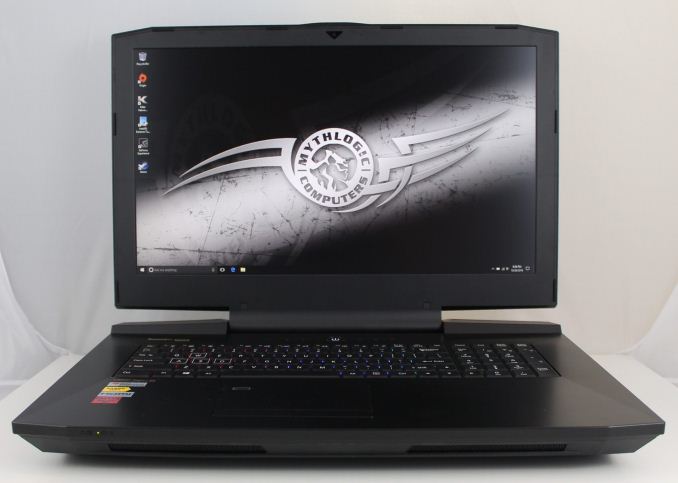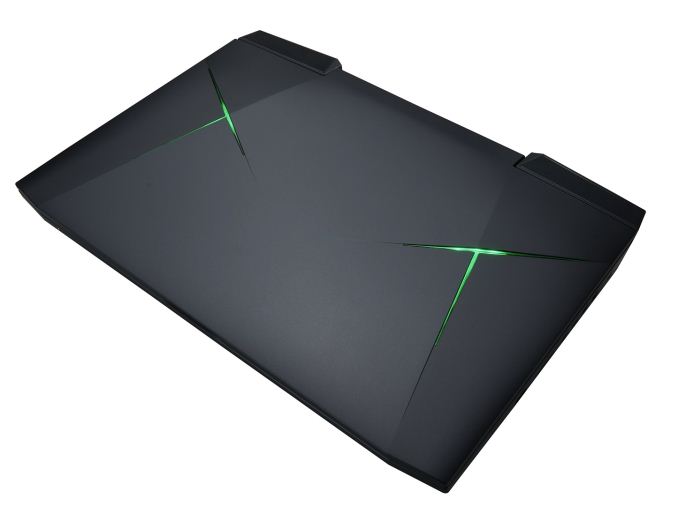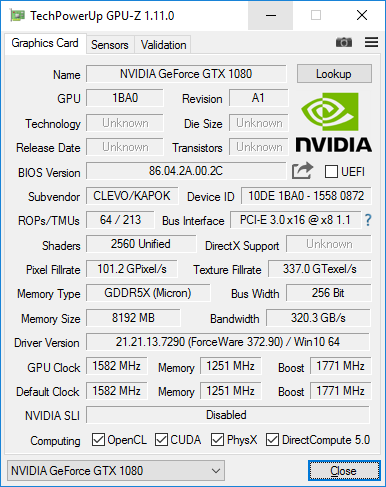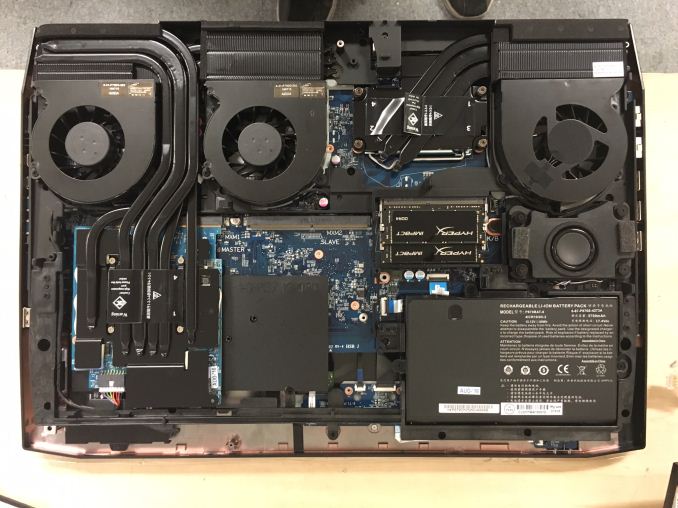The Clevo P870DM2 / Mythlogic Phobos 8716 Laptop Review: DTR With GTX 1080
by Brett Howse on October 27, 2016 2:00 PM EST
Sometimes there is no substitute for performance. Most of the laptop market is focusing on thin and light designs, with companies attempting to outdo each other by shaving a millimeter or two off of their laptop z-height compared to the competition. But in the Desktop Replacement (DTR) category, there are no such concessions. Clevo is one of the few laptop makers that is in the DTR market, and thanks to the assistance of Mythlogic, we have the Mythlogic Phobos 8716 DTR for review today. As a Clevo, the model would be P870DM2.
Let’s cut right to the chase. The Mythlogic Phobos 8716 is a beast of a laptop, and really should rarely be used in your lap. It is designed for someone who needs the ultimate performance, but still needs something more portable than a full desktop. This is a 17.3-inch display packed into a chassis that is 47.2 mm thick (1.86”) and weighs in at 5.5 kg (12.13 lbs) with a single GPU. And yes, you can opt for two GPUs, which ups the weight and moves you into the land of ridiculous.
Mythlogic offers a couple of choices of CPU and GPU, but all the CPUs are desktop parts, from the Intel Core i5-6400 65-Watt processor up to the Intel Core i7-6700K 91-Watt processor (as we have in the review unit). This is the same unlocked quad-core as you would find in any high performance desktop. On the GPU side, the base model is a mere GTX 1070, or step up to the GTX 1080, or either card in SLI. If you get dual GTX 1080 GPUs, be prepared to have two AC outlets handy for the dual 330-Watt AC Adapters. Mythlogic also supports overclocking on all of the components. There are four SODIMM slots for up to 64 GB of DDR4 memory as well. This is well and truly a desktop class computer packed into a (somewhat) portable chassis.
The display options also need mentioning too. The standard panel is a 1920x1080 IPS display with a 120 Hz refresh rate. That should be a very significant upgrade for almost anyone, up from the ubiquitous 60 Hz laptop displays. They are also offering a 2560x1440 AHVA 120 Hz panel with G-SYNC option, and a 3840x2160 60 Hz AVHA panel which also includes G-SYNC.
| Mythlogic Phobos 8716 / Clevo P870DM2 | |
| As Tested: 6700K, 16GB (2x8) 2400 DDR4, 1x1080, 256GB Samsung 950 Pro m.2, 120Hz FHD, $2980 USD |
|
| CPU | Intel Core i5-6400, 4C/4T, 2.7-3.3 GHz, 6MB Cache, 65W TDP |
| Intel Core i5-6500, 4C/4T, 3.2-3.6 GHz, 6MB Cache, 65W TDP | |
| Intel Core i5-6600, 4C/4T, 3.3-3.9 GHz, 6MB Cache, 65W TDP | |
| Intel Core i5-6600K, 4C/4T, 3.5-3.9 GHz, 6MB Cache, 91W TDP | |
| Intel Core i7-6700, 4C/8T, 3.4-4.0 GHz, 8MB Cache, 65W TDP | |
| Intel Core i7-6700k, 4C/8T, 4.0-4.2 GHz, 8MB Cache, 91W TDP | |
| GPU | NVIDIA GTX 1070 8GB, 2048 CUDA Cores , 1442 - 1645 (Boost) MHz Also available as 2 x SLI |
| NVIDIA GTX 1080 8GB, 2560 CUDA Cores, 1556 - 1733 (Boost) MHz Also available as 2 x SLI |
|
| Memory | 4 SODIMM Slots, 64 GB Max, up to 3000 MHz |
| Display | 17.3" 1920x1080 IPS 120Hz Optional 2560x1440 AHVA 120 Hz w/G-SYNC Optional 3840x2160 AHVA 100% Adobe RGB w/G-SYNC |
| Storage | 2 x 9.5mm 2.5” SATA 2 x m.2 Slot (SATA or 4xPCIE) |
| I/O | 5 x USB 3.0 Ports (1 x powered USB port, AC/DC) 2 x USB 3.1 / Thunderbolt 3 Port (Type-C) 1 x HDMI 2.0 output Port (with HDCP) 2 x DisplayPort 1.3 output Ports SD Card Slot 1 x Headphone Jack 1 x Microphone Jack 1 x Line-in Jack 1 x S/PDIF (digital) (Shared with headphone jack) 2 x Killer E2400 RJ-45 LAN (10/100/1000Mbps) |
| Dimensions | 428 x 308 x 47.2 mm 16.85 x 12.12 x 1.86 inches |
| Weight | 5.5 kg / 12.13 lbs (single GPU) |
| Battery | 82 Wh, 330W / 230W W AC Adapter |
| Wireless | Intel Dual Band Wireless-AC8260 2x2:2 with Bluetooth 4.1 Killer Wireless-AC 1535 2x2:2 with Bluetooth 4.1 |
| Price | $2255 - $5000+ |
There is no shortage of ports, with five USB 3.0 ports, two USB 3.1 Type-C ports with Thunderbolt 3, HDMI 2.0, two DisplayPort 1.3, and separate audio jacks for the headphone, microphone, and line-in. It also features a Killer E2400 Ethernet adapter, and that wired connection can be paired with either the Killer 1535-AC wireless to support Killer’s DoubleShot Pro, or Intel’s Dual Band Wireless-AC 8260 card if you prefer their solution.
With a starting price of $2255, the Mythlogic Phobos could never be considered inexpensive, but on the performance per dollar metric, there are few laptops that offer this kind of performance period, let alone for the price.













61 Comments
View All Comments
DanNeely - Friday, October 28, 2016 - link
I know there aren't any officially published numbers, I was hoping you could measure power to get approximate ones.Ratman6161 - Thursday, October 27, 2016 - link
"Clevo is one of the few laptop makers that is in the DTR market"Not really true. Dell, HP, and Lenovo all make laptops in the 15 to 17 inch size with quad core CPU's, loads of RAM, NVMe drives etc. They are lighter, less expensive (generally speaking) and with better battery life. Of course the specs you have are saying they are using desktop CPU's instead of somthing like the i7-6700HQ, an actual quad core mobile CPU as used in the others. As workstation focused machines they also tend to use the Quadro GPU's rather than the gaming focused. But it doesn't take too much looking to find DTR class laptops.
eriri-el - Thursday, October 27, 2016 - link
I can't seem to find anywhere that a TI/Burr Brown DAC in in this thing. Sources below says audio is powered by an ESS Sabre DAC, which is known for its bad implementations by alot of manufaturers, making it sound way inferior compared to other DACs.https://www.mythlogic.com/2016_Models/phobos8716.p...
http://forum.notebookreview.com/threads/official-c...
Hopefully you can clarify if it exists, where can get the TI/Burr Brown DAC edition, thx.
LaggLad - Thursday, October 27, 2016 - link
Yes they have the ESS Sabre DAC and Burr Brown AMP.Meaker10 - Thursday, October 27, 2016 - link
ES9018 + LM49720 + OPA1622 ;)df2rools - Thursday, October 27, 2016 - link
"If so, fret not. The GTX 1080 does not too bad on this game."That sure is some English right there. (dota 2 performance section.
boeush - Thursday, October 27, 2016 - link
I have a Clevo in the same chassis (built by Sager), bought early last spring - so I'm a little behind on components now, what with a 980M and only 16 GB of RAM -- but still with a 6700K. I might upgrade the GPU later in 2017, when the next-gen stuff comes out with HBM2, better power/perf/process optimizations, and/or what-not. But I'm stuck with a 1080p screen since the 1440p wasn't available for order back then.Anyway, yeah some aspects of this rig are unnecessary or unrefined and garish. The LED highlights on the lid, for one. Why, indeed. The weird randomized keyboard backlighting on boot-up, with user-customized settings not kicking in until you log in and load the Windows desktop. Yeah, the touch pad is a little glitchy (on occasion it stops working; the workaround is usually to disable/re-enable it via a function key combo.) I had to get a Windows 7 Pro running on it for some work-related reasons, so I set up an MBR boot on the secondary SSD and have to manually toggle the UEFI boot off in the BIOS every time I want to boot into Win 7; after playing around I was able to get it all working but for whatever reason the Windows 7 boot under BIOS emulation sees only ~2 GB of the installed RAM (so after the OS takes its share, applications only have ~1 GB to play with.) I consider this a design bug, though probably not too many people would care at this point and so it's not likely to ever be fixed; plus, none of the drivers (including UEFI/BIOS firmware) for this machine have any updates available from Sager since October of 2015... (Maybe Mythlogic is better than Sager about that? Or maybe not; I wouldn't know...)
I do wish the keyboard was better, and that overall the user-facing design elements better leveraged the available real estate. There are huge - unbelievably and utterly wasted - margins around the keyboard; it would have been better if the keys were larger and/or better spaced out, with the keyboard spanning the entire width of the laptop. Ditto for display. The bezels are obscenely enormous; they could (and should!) have easily fitted in an 18"+ screen with thinner bezels.
Ascaris - Friday, October 28, 2016 - link
Why would you have to disable UEFI boot and use MBR to boot Windows 7 on the secondary SSD? That would suggest it is the x86 version... would x64 not work with your work-related stuff?boeush - Friday, October 28, 2016 - link
Yeah, forgot to mention for work it has to be the 32-bit version of Windows 7, not x64 (yeah I know, it sucks - but one would still expect it to see/use 4 GB of the installed RAM, instead of just 2...) Anyway, Windows 7 won't even install on a disk unless it's formatted with MBR (you can't select GPT disks as targets in the installer UI - they are disabled/grayed out.) And unless UEFI boot is disabled, the machine automatically boots from the primary GPT-formatted disk (where the Win 10 install is that came with the machine and I otherwise use regularly.)boeush - Friday, October 28, 2016 - link
BTW, you might think one possible workaround could be to just run the 32-bit Win 7 in a VM - but unfortunately I need hardware-accelerated 3D graphics to work correctly, and VMs still tend to have big problems with that even today.